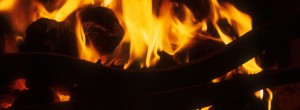Don’t Play with Fire (in Scotland)! November 29, 2011
Author: Beach Combing | in : Medieval, Modern, Prehistoric , trackbackIn prehistoric times early humans – or, depending on which chronologies you follow, man’s ancestors – were not able to create fire but harvested it from natural conflagrations. Even in more recent times – ask any scout who has ever had to start a fire without matches on a camping trip – the creation of fire was a labour. Not surprisingly then a series of beliefs and taboos built up around fire-making and, above all, fire sharing. These beliefs – that might be for all we know be Neolithic in origin – survived surprisingly late in some rural quarters. The following three accounts all come from nineteenth-century Scotland: they relate – though precise dates are lacking – to the period c. 1850-1880. To share fire, it transpires, was a potentially risky business on the other side ofthe border a little over a century ago.
1) (290) At Craigmillar, near Edinburgh, a woman, not long ago, refused to give a neighbour a bit of peat to light her fire, because she was supposed to be uncanny. The old woman muttered, as she turned away, that her churlish neighbour might yet repent of her unkindness. This speech the other repeated to her husband on his return from work, whereupon he went straight to the old woman’s house, and gave her a sharp cut on the forehead, for which he was duly called to account, and pleaded his belief that scoring the witch above the breath would destroy her glamour [magic].
2) [I]n Ross-shire, an old beldame repaired to a neighbour’s house with this intent [taking fire]. There was only a child of eight years old at home, but she was thoroughly acquainted with the popular superstition, and stoutly refused the applicant tinder, match, or lighted stick. When the old woman had departed, the girl fetched two friends, who straightway followed her home, to find there a blazing fire and a boiling, pot. ‘See you’, exclaimed the lassie, ‘gin the cailliach had gotten the kindling, my father would not get a herring this year’.
3) A poor tinker’s wife walked one morning into a house in Applecross – this was as late as July, 1868 – and snatched alive peat from the hearth to kindle her own fire. Before she had gone any distance, she was observed, and the gudewife sped after her, overtook her, and snatched away her prize. To a stranger who remonstrated with her for the unkindness, the gudewife exclaimed, ‘Do you think I am to allow my cow to be dried up? If I allowed her to carry away the fire, I would not have a drop of milk to-night to wet the bairns’ mouths.’ And she flung the peat into a pail of water in order to undo the evil charm so far as possible.
Any other unusual fire beliefs surviving this late? drbeachcombing AT yahoo DOT com
***
31 Dec 2011: Jon K: ‘I’ve just read your post on fire superstitions and have one for the pot. It was a common practice for those in out Northern climes to keep a fire burning in the hearth all year round. In some communities they would smother the fire on Beltane/ Bealltainn and relight it using a brand from the bonfire. Quite evocative! Naturally, many superstitions and customs were generated by such a focal point. Preamble aside, there’s an inn in Dartmoor that has kept their fire burning for centuries. Somehow, local tradition holds the belief that the devil was tricked and remains trapped beneath the hearth. Should the fire ever be extinguished, Old Nick will will spring forth and make merry mischief with the world again. Unfortunately, the great winds of 1987 flooded the inn and the fire was doused. It later re-opened and, as far as I remember, continues to keep the fire going; whether civic duty or a good draw for the tourists is anyone’s guess. This legend exists in another pub on the N Yorkshire moors. Alas, I have to leave for work and can’t provide the names of either despite having visited the Dartmoor one.’ Thanks Jon!
_



